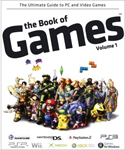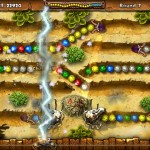Originally Written for KillaNet Community Resource in 2006
 The Book of Games, Volume 1
The Book of Games, Volume 1
by Bendik Stang
Hardcover: 448 pages
Publisher: gameXplore N.A. Inc.
November 2006
The Book of Games is a comprehensive look at hundreds of the current top video games on the market. It is obvious that alot of time and research has gone into this volume, with attention paid to detail. From first page to last, this book is full of information relative to the video game end market. Its pages are filled with vibrant full-colour screenshots from the games covered, and in the individual game listings, the screenshots offer a very accurate view of what to expect during gameplay. This includes not only the high quality graphics for the games themselves, but also shots of what to expect in regards to violence in the game.
The title page for each game genre has thumbnail shots of retro games, showing the progression of game development. As a longtime gamer, I would have liked to have seen more material on the history of video gaming and the advances which have been made in the industry. Naturally, such a focus could easily fill a volume all on its own, and was not the purpose of this publication. The chapter on the future of gaming carries some interesting predictions. First and foremost is the prediction that those parents who purchase a Wii will themselves get involved in video gaming (if they aren’t already). I find this an interesting prediction, because that is exactly what Nintendo hopes will happen, and the reason for its basic yet futuristic control system. This very prediction was discussed at a recent panel night hosted by the Vancouver chapter of the International Game Developers’ Association. I was pleased to see the interactive future of video games given more than just a passing glance, along with the practical side of video game usage in scenario training. As someone involved in the video game industry, this is important to me primarily because of the general public’s opinion of video gaming. They often are not aware of the benefits of this industry, and The Book of Games does a good job of passing along this important information.
Each game genre is indexed into alphabetical sections with colour-coded page edges and a brief description of the genre. There are accompanying appendices at the end of the book which further break down the game genres according to age ratings for ESRB and PEGI, so it is practical for those whose countries follow these rating systems. The games list is also cross-referenced alphabetically and by platform. Also included is a glossary, which will be especially useful for the non-gaming geek parents of the world. There is also a calendar of notable dates in the game industry for 2006; unfortunately I noted one small error in the calendar: the release date for Guild Wars: Factions was April 28, not March 28 as stated in the book.
Going back to the genre sections, I noted that some sections were a bit on the thin side while others held abundant game listings. A section which I would’ve expected to see more listings for was RPG. Two of the biggest selling Multi-Player Online roleplaying games for this genre were not listed at all. In May of 2006, Guild Wars: Factions became the top-selling PC game in North America and Europe, surpassing World of Warcraft, yet Guild Wars warranted nothing other than a thumbnail screenshot in the feature chapter about the MMORPG genre. Neither Guild Wars nor World of Warcraft were listed in the indexed RPG chapter, where only five games of a huge genre were given coverage. While Warcraft was given more coverage in the MMORPG feature chapter, I feel that the chapter could’ve gone more indepth on a genre which is so hugely popular on a global scale. The feature chapter about the making of Age of Conan was a somewhat interesting read, particularly as the game is so highly anticipated, largely due to its being one of the first large-scale games written for Vista.
The short feature chapter about the cross-over of games to movies, while giving an honest opinion about the growing trend, again could have gone further indepth. The fastest growing industry is New Media, and the lines are blurring between the traditional industries, largely due to the technological advances. Two of my screen-writing friends are currently working on a Uwe Boll movie, so this chapter held some special interest for me. I felt there could’ve been more mention of the cross-overs and mass-marketing benefits the video game industry is seeing from the inclusion of cartoons, comic books, movies, and of course television.
The feature chapter on gaming consoles again could’ve gone a little more indepth, comparing those early consoles (Pong, anyone?) with how far the industry has come. There was no mention of the early consoles which really opened up the home video game industry such as Atari and Sega. I know that I said earlier in this review that the history of gaming really wasn’t the scope of this publication, but this is one area I felt should’ve been further expanded. I understand that the Book of Games is expected to become an annual publication, so perhaps many areas will be expanded in the future.
Overall, I found this to be an enjoyable book to read, and one that will prove useful in the future. I think it would make a nice gift for most gamers, and at the very least will get them away from their consoles for awhile. There are a few online references given where readers can watch a video battle between Sonic and Mario as well as check out some other game research sites. The volume is full of good information and well laid out; I am giving it a thumbs-up recommendation and feel it worth the purchase price.
 Print This Post
Print This Post
![[Wii] Mario Kart Wii (US Edition) Packshot Mario Kart Wii (US Edition)](http://www.villagegamer.net/wp-content/uploads/2008/05/mario_kart_wii.png)





